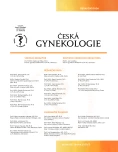Questionnaire study of prevalence of urinary incontinence in pregnancy and early six weeks
Authors:
K. Horáková; L. Horčička
Authors‘ workplace:
GONA spol. s. r. o., gynekologicko-porodnická praxe, Praha, vedoucí lékař MUDr. L. Horčička
Published in:
Ceska Gynekol 2020; 85(3): 181-186
Category:
Overview
Objective: Detect prevalence of urinary incontinence in pregnant women depending on risk factors.
Design: Questionnaire study.
Setting: GONA company s.r.o., Gynaecology and Obstetrics Practise.
Case report: During the annual follow-up, 20 women out of a total reported complaining about the incontinence of power. The trouble was discreet, the women did not limit, they could engage in all activities. They wore inserts as a precaution, but did not shed their fluid intake and were unconcerned by the posible stench of escaping power. Women had the most trouble after 30 weeks of gestation, the condition improved after delivery and none of the interviewees had trouble escaping after six weeks. Three women devoted themselves to rehabilitate after giving birth.
Conclusion: Pregnancy is a specific condition for a womanś body, so the changes that occur in this area can only mimic the symptoms of incontinence and hyperactive bladder. Prevention before and during pregnancy plays an important role. Collaboration with a physical therapist is appropriate. Preventive strengthening of the pelvic floor reduces the incidence of urinary incontinence.
Keywords:
gravidity – Incontinence – risk factors
Sources
1. Abrams, P., Cardoso, L., Wagg, A., Wein, A. Incontinence 6th Edition 2017, 6th International Consultation on Incontinence, Tokyo, September 2016, p. 375–388.
2. Bazi, T., Takahashi, S., Ismail, S., et al. Prevention of pelvic floor disorders: international urogynekological association research and development committee opinion. International Urogynecol J, 2016, 27, p. 1785–1795.
3. Callewaert, G., Albersen, M., Janssen, K, et al. The impal of vaginal delivery on pelvic floor fiction - delivery as a time point for secondary preventiv: A commentary. BJOG, 2015, 123, 5, p. 678–681.
4. Delancey, JOL., Kane Low, L., Miller, JM., et al. Graphic integration of causal factors of pelvic floor disorders: an integrated life span model. AJOG, 2008, 199, 6, p. 610.e1–5.
5. Dietz, HP., Lanzarone, V. Levator trauma after vaginal delivery. Obstet Gynec, 2005, 106, 4, p. 707–712.
6. Eason, E., Labrecque, M., Marcoux, S., et al. Effect of carving a pregnancy and of the method of delivery on urinary incontinence: a prospective kohort study. BMC Pregnancy Childbirth, 2004, 4, p. 4.
7. Gyhagen, M., Akervall, S., Milsom, I. Clustering of pelvic floor disorders 20 years after one vaginal or one cesarean birth. Urogynecol J, 2015, 26, 8, p. 118–1121.
8. Halaška, M., et al. Urogynekologie. Praha: Galén, 2004, s. 173–177.
9. Horčička, L., et al. Inkontinence moči v každodenní praxi. Praha: Mladá fronta, 2015, s. 85–90.
10. Howard, D., Makhlouf, M. Can pelvic floor dysfunction after vaginal birth be prevented? Intern Urogynecol J, 2016, 27, p. 1811–1815.
11. Jing, D., Ashton-Miller, JA., DeLancey, JOL. A subject-specific anisotropic visco-hyperelastic finite element model of fiale pelvic floor stress and strain during the sekond stage of labor. J Biomechanics, 2012, 45, 3, p. 455–460.
12. Law, YM., Fielding, JR. MRI of pelvic floor dysfunction: Review. Amer J Roentgenol, 2008, 191, 6, suppl., p. 45–53.
13. Martan, A., et al. Nové operační a léčebné postupy v urogynekologii, druhé, rozšířené a přepracované vydání. Praha: Maxdorf, 2013, s. 50–53.
14. Rortveit, G., Daltveit, AK., Hannestad, YS., et al. Urinary inkontinence after vaginal delivery or cesarean section. New Engl J Med, 2003, 348, p. 900–907.
15. Rortveit, G., Daltveit, AK., Hannestad, YS., et al. Vaginal delivery parameters and urinary incontinence, The Norwegian EPINCONT study. Amer J Obstet Gynecol, 2003, 189, p. 1268– 1274.
16. Rušavý, Z. Poruchy pánevního dna po porodu. Acta Med, 2016, 4, s. 31–32.
17. Švabík, K., Martan, A. Těhotenství, porod – poruchy pánevního dna a inkontinence moči. Mod Gyn Por, 2003, 12, 1, s. 37–45.
18. Tunn, R., DeLancey, JOL., Howard, D., et al. Anatomic variations in the levator ani muscle, endopelvic fascia and urethra in nulliparas evaluated by magnetic resonance paging. AJOG, 2003, 188, 1, p. 116–121.
19. Urbánková, I., Hympánová, L., Krofta, L. Ovce jako experimentální model pro studium vlivu těhotenství, porodu a operačních technik na pánevní dno. Čes Gynek, 2017, 82, 1, s. 54-58.
20. van Delft, K., Thakar, R., Sultan, A., et al. Levator ani muscle avulsion during childbirth: a risk prediction model. BJOG, 2014, 121, 9, p. 1–10.
21. Vaverková, A., Kališ, V., Rušavý, Z. Informovanost rodiček v oblasti primární a sekundární prevence poruch pánevního dna po porodu. Čes Gynek, 2017, 82, 4, s. 327–332.
22. Wesnes, SL., Rortveit, G. Urinary incontinence during pregnancy. Obstet Gnecol, 2007, 109(4), p. 922–928.
23. Wilson, D., Dornan, J., Milsom, I., et al. UR-CHOICE: can we provide mothers -to be with information about the risk of future pelvic floor dysfunction? Intern Urogynecol J, 2014, 25, p. 1449–1452.
24. Zmrhal, J., Hradec, D., Hejlová, P. Některé funkční změny dolních močových cest v těhotenství a po porodu. Prakt Gynek, 2009, 1, s. 26–28
Labels
Paediatric gynaecology Gynaecology and obstetrics Reproduction medicineArticle was published in
Czech Gynaecology

2020 Issue 3
Most read in this issue
- Native IVF cycle at woman in 46-age with clinical pregnancy
- Prolongated pregnancy: unusual case
- New estrogen-free oral hormonal contraceptive (Estrogene free ill-EFP)
- Dissecting leiomyoma of the uterus with unusual clinical and pathological features
